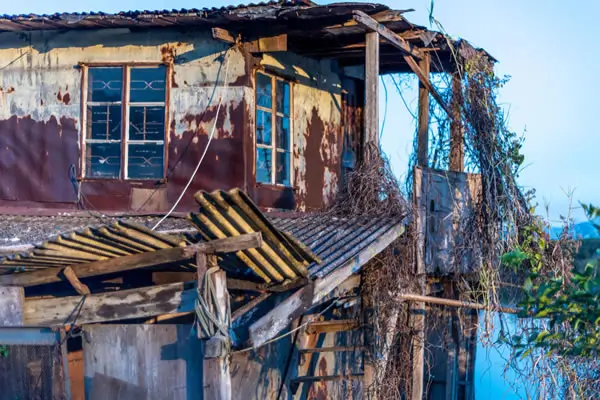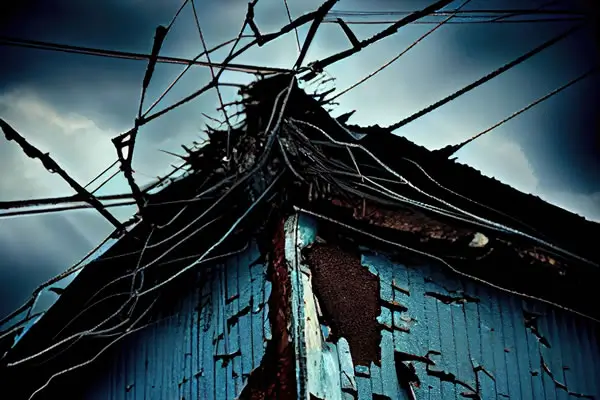If Lightning a Strikes Home – Devastating Experience
If lightning strikes a home, it can lead to various consequences, depending on the path the lightning takes and the materials it encounters. Here are some potential outcomes when lightning strikes a house:
When Lighting Strikes a Home Can Cause a Fire:
One of the most serious threats is the risk of fire. Lightning can ignite flammable materials in the home, such as wood, insulation, or gas lines. Electrical wiring and appliances can also be damaged, leading to sparks that may start a fire.
Electrical Damage when Lighting Strike on Home:
Lightning carries a powerful electrical charge, and when it strikes a home, it can damage or destroy electrical systems, including wiring, outlets, and electronic devices connected to the power grid. This damage may lead to power surges within the home.
Structural Damage to the house due to Lightning strike
The force of a lightning strike can cause structural damage to a building. It may damage roofing materials, chimneys, or other components. In some cases, lightning can create cracks in walls or even cause a partial collapse.
Lightning Strike can cause Appliance Damage:
Lightning can damage or destroy electronic appliances and devices that are connected to electrical outlets. This includes computers, TVs, refrigerators, and other household electronics.
Shock Waves and Sound Damage when Lightning Strikes Home:
The shock waves generated by a lightning strike can result in damage to windows and other glass surfaces. The intense sound produced by the thunderclap can also cause hearing damage if someone is in close proximity to the strike.
Ground Currents when Lightning Strikes:
Lightning can induce ground currents that travel through plumbing and electrical systems. This can pose a risk to individuals inside the home who are in contact with conductive materials, such as faucets or electrical appliances.
Power Surges due to Lightning Strikes:
Lightning can cause power surges in the electrical system of a home. This surge can damage or destroy connected devices and appliances, even if the lightning did not directly strike the house.
To minimize the risk of lightning damage to a home, it’s advisable to install a lightning protection system, which typically includes lightning rods and grounding. Additionally, using surge protectors for electronic devices and unplugging appliances during severe thunderstorms can help prevent damage. If lightning strikes a home, it’s crucial to assess the extent of the damage and, if necessary, evacuate the premises and contact emergency services.

News Video of Lighting Strikes a House
News Video of Lighting Strikes a House
See FOX News Article –
Homeowners left their house to get lunch moments before structure was struck by lightning: See it happen
The homeowners left just minutes ahead of the lightning strike
https://www.foxnews.com/lifestyle/homeowners-left-house-get-lunch-moments-structure-was-struck-lightning-see-it-happen
Signs that your home was struck by lightning
Lightning strikes on homes can cause various signs of damage, and it’s essential to be vigilant in identifying these signs promptly. If you suspect that your home has been struck by lightning, here are some common signs to look for:
- Fire:
- The most severe consequence of a lightning strike is the risk of fire. If your home was struck, check for any signs of fire or smoke. Inspect the attic, roof, and other areas where a fire may have started.
- Smoke or Burning Odor:
- Even if a fire isn’t immediately visible, a lightning strike can cause smoldering or small fires within walls or in the attic. If you notice a burning smell or see smoke, it could indicate hidden fire damage.
- Electrical Issues:
- Lightning can cause electrical surges that damage wiring and appliances. Look for signs of electrical issues such as flickering lights, tripped circuit breakers, or appliances not functioning correctly.
- Damaged Electronics:
- Lightning can damage electronic devices and appliances connected to electrical outlets. Check for any non-functioning electronics, burnt outlets, or damaged appliances.
- Structural Damage:
- Lightning can cause structural damage to a building. Inspect the roof, walls, and foundation for any visible damage, such as cracks, holes, or displaced materials.
- Burn Marks:
- Examine the exterior and interior of your home for burn marks, especially around the roof, attic, and electrical panels. Burn marks may indicate the path taken by the lightning through the structure.
- Scorching or Melting:
- Lightning can cause scorching or melting of materials it comes into contact with. Look for signs of melting on electrical wiring, roofing materials, or other susceptible surfaces.
- Damaged Trees or Nearby Objects:
- If there are trees or other tall objects near your home, check for signs of damage, such as bark stripping or splintering, which could indicate a nearby lightning strike.
- Disruption of Plumbing Systems:
- Lightning can travel through plumbing systems, causing damage. Check for leaks, bursts, or other abnormalities in your plumbing system.
- Damaged Lightning Protection System (if installed):
- If you have a lightning protection system, inspect it for any signs of damage. The lightning rod, conductors, and grounding components should be intact and properly connected.
If you observe any of these signs, it’s crucial to prioritize safety and take immediate action. Contact emergency services if there is a fire, and consult with professionals to assess and address any structural or electrical damage caused by the lightning strike.
Florida based lightning protection company Coastal Lightning Rods offers design, installation, test and maintenance of lightning and surge protection and earthing systems. We ensure you that our installation of a lightning protection system on your property will be of the highest standard. We provide lightning protection services throughout the state of Florida, entire South East, Gulf Coast and Atlantic Coast. We also provide lightning protection in Alabama, South Carolina, Louisiana, Florida, Mississippi, Tennessee and beyond.

